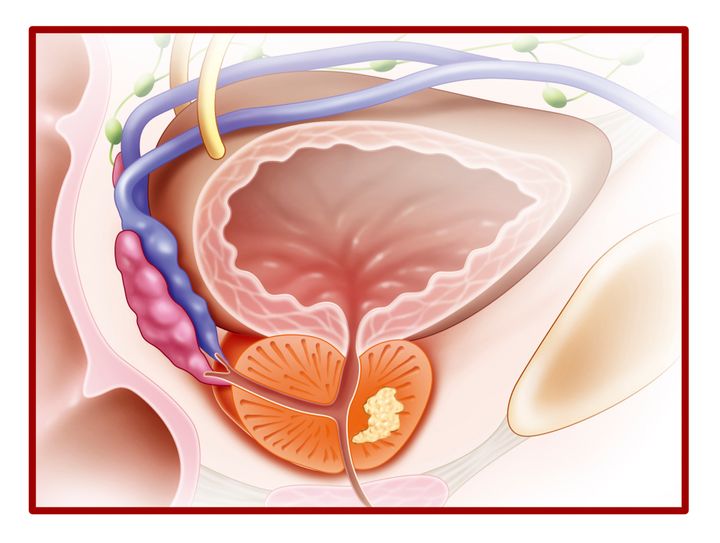

An estimated 180,890 American men will be diagnosed with prostate cancer this year. The disease will also take the lives of 26,120 patients. But according to a new 10-year study conducted on more than 1,500 men in the United Kingdom, those who are diagnosed may want to hold off on starting aggressive treatment right away.
Typically, men who are diagnosed with prostate cancer are given several options: Have surgery to remove all or part of the gland, undergo radiotherapy to reduce any tumors, or take a “watch and wait” active monitoring approach, which involves additional screenings and biopsies but no treatment, as the cancer can grow so slowly that it often doesn’t present a medical problem for those who have it.
The study, published Wednesday in the New England Journal of Medicine, found that men who received treatment ― either surgery or radiotherapy ― were better able to limit their cancer from spreading. But this didn’t necessarily mean immediate treatment led to better overall outcomes. Among the men who took a “watch and wait” approach, nearly half didn’t need any additional treatment. As a result, they avoided the negative side effects that come with surgery and radiation, such as bowel and urinary incontinence, sexual dysfunction and life-threatening cardiovascular issues.
Indeed, no matter what approach the men were randomized to, they weren’t likely to die of either the cancer itself, cancer treatment or other causes after ten years. That said, the patients in this study are still being followed because deaths from prostate cancer are usually measured after 15 to 20 years.
“This paper really underscores that an active surveillance approach is good for many patients, but there are some who still need upfront treatment,” said Dr. Timothy J. Daskivich, a urologic oncologist and director of health services research for the Cedars-Sinai department of surgery in Los Angeles. “Time will tell if we can sort these patients out in the future.”
While some men will need immediate treatment, further developments that help urologists identify low-risk and high-risk patients will be key to making sure that only men who need it the most will have to undergo surgery or radiation.
How outcomes differed according to the treatment
The Prostate Testing for Cancer and Treatment (ProtecT) trial recruited U.K. men ages 50 to 69 from 1999 to 2009. Of 2,664 men who received a diagnosis of prostate cancer, 1,643 agreed to be randomized to any one of three of the most common prostate cancer treatments: active monitoring (545 men), radical prostatectomy (553 men) or radiotherapy (545 men).
The men were not further classed into low- or high-risk groups based on the features of their tumor or the levels of prostate-specific antigens in their blood. This is what the researchers found:
There was no difference in death rates. The scientists followed up with the men after a median of 10 years and found that while there were less prostate cancer-specific deaths in the groups that got radiation or surgery, the difference was not significant, and all groups had at least a 98.8 percent survival rate when it came to prostate cancer-specific deaths. In all, the death rate from prostate cancer across all groups was about one percent after a median of ten years.
There was a difference in the rate of cancer spread. Of the men who were randomized to the active monitoring group, 112 experienced disease progression, including cancer spread, which was higher than in the surgery and radiation groups (46 and 46, respectively). While there appears to be a slight advantage to getting treated immediately after a prostate cancer diagnosis to avoid cancer progression, longer-term follow up is needed to see if these results are significant, the researchers wrote.
What this means for U.S. men
In an opinion piece that accompanied the study, Dr. Anthony V. D’Amico of the Dana-Farber Cancer Institute concluded that when compared with surgery or radiation, active monitoring leads to increased cancer spread, and that active monitoring should only be an option for men who already have another life-shortening disease that is expected to result in death after less than 10 years.
Daskivich, who was not involved with the study, was more optimistic about active monitoring’s place in prostate cancer care, and included “low-risk” men among those who should consider active monitoring instead of surgery or radiation, even though the study didn’t stratify men according to high or low risk cancers. However, doctors still need more tools that help them confidently sort patients according to risk.
“It’s all about treatment selection ― picking out patients who have higher risk disease who should get treated upfront, and those who have lower risk features who don’t need to be treated and managed with active surveillance,” said Daskivich. “That’s going to be the challenge in the coming years.”
The results of the study won’t change much for most middle-aged men in the U.S., Daskivich said, because many academic centers and urologists are already taking an active monitoring approach to men with localized prostate cancers. Currently in the U.S., about 40 to 50 percent of men opt for active monitoring when they get a diagnosis of prostate cancer, reports the New York Times.
Further observation of the ProtecT group will be key to figuring out if the difference in cancer progression between the three groups, or the difference in deaths, makes one approach an obvious choice over the other two.
